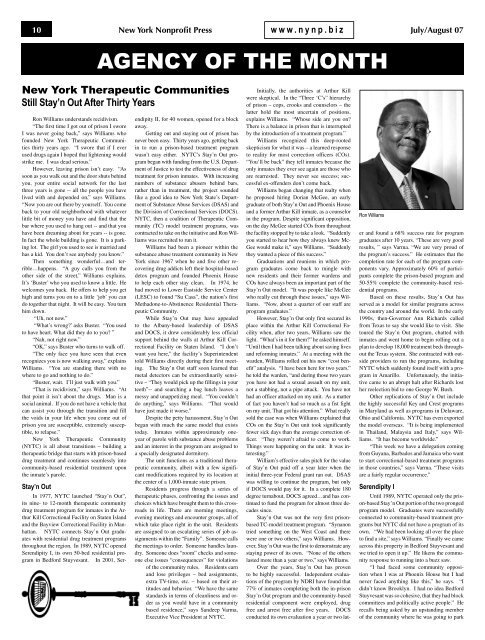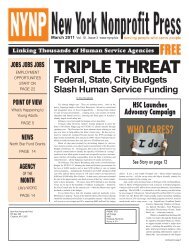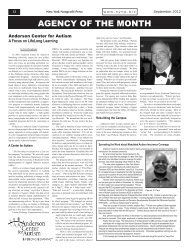New York Therapeutic Communities, Inc.: Still Stay'n Out after 30 ...
New York Therapeutic Communities, Inc.: Still Stay'n Out after 30 ...
New York Therapeutic Communities, Inc.: Still Stay'n Out after 30 ...
You also want an ePaper? Increase the reach of your titles
YUMPU automatically turns print PDFs into web optimized ePapers that Google loves.
10 <strong>New</strong> <strong>York</strong> Nonprofit Press www.nynp.biz July/August 07<br />
AGENCY OF THE MONTH<br />
<strong>New</strong> <strong>York</strong> <strong>Therapeutic</strong> <strong>Communities</strong><br />
<strong>Still</strong> Stay’n <strong>Out</strong> After Thirty Years<br />
Ron Williams understands recidivism.<br />
“The first time I got out of prison I swore<br />
I was never going back,” says Williams who<br />
founded <strong>New</strong> <strong>York</strong> <strong>Therapeutic</strong> <strong>Communities</strong><br />
thirty years ago. “I swore that if I ever<br />
used drugs again I hoped that lightening would<br />
strike me. I was dead serious.”<br />
However, leaving prison isn’t easy. “As<br />
soon as you walk out and the door shuts behind<br />
you, your entire social network for the last<br />
three years is gone -- all the people you have<br />
lived with and depended on,” says Williams.<br />
“Now you are out there by yourself. You come<br />
back to your old neighborhood with whatever<br />
little bit of money you have and find that the<br />
bar where you used to hang out -- and that you<br />
have been dreaming about for years -- is gone.<br />
In fact the whole building is gone. It is a parking<br />
lot. The girl you used to see is married and<br />
has a kid. You don’t see anybody you know.”<br />
Then something wonderful…and terrible…happens.<br />
“A guy calls you from the<br />
other side of the street,” Williams explains.<br />
It’s ‘Buster’ who you used to know a little. He<br />
welcomes you back. He offers to help you get<br />
high and turns you on to a little ‘job’ you can<br />
do together that night. It will be easy. You turn<br />
him down.<br />
“Uh, not now.”<br />
“What’s wrong?’ asks Buster. “You used<br />
to have heart. What did they do to you? ”<br />
“Nah, not right now.”<br />
“OK,” says Buster who turns to walk off.<br />
“The only face you have seen that even<br />
recognizes you is now walking away,” explains<br />
Williams. “You are standing there with no<br />
where to go and nothing to do.”<br />
“Buster, wait. I’ll just walk with you.”<br />
“That is recidivism,” says Williams. “At<br />
that point it isn’t about the drugs. Man is a<br />
social animal. If you do not have a vehicle that<br />
can assist you through the transition and fill<br />
the voids in your life when you come out of<br />
prison you are susceptible, extremely susceptible,<br />
to relapse.”<br />
<strong>New</strong> <strong>York</strong> <strong>Therapeutic</strong> Community<br />
(NYTC) is all about transitions – building a<br />
therapeutic bridge that starts with prison-based<br />
drug treatment and continues seamlessly into<br />
community-based residential treatment upon<br />
the inmate’s parole.<br />
Stay’n <strong>Out</strong><br />
In 1977, NYTC launched “Stay’n <strong>Out</strong>”,<br />
its nine- to 12-month therapeutic community<br />
drug treatment program for inmates in the Arthur<br />
Kill Correctional Facility on Staten Island<br />
and the Bayview Correctional Facility in Manhattan.<br />
NYTC connects Stay’n <strong>Out</strong> graduates<br />
with residential drug treatment programs<br />
throughout the region. In 1989, NYTC opened<br />
Serendipity I, its own 50-bed residential program<br />
in Bedford Stuyvesant. In 2001, Serendipity<br />
II, for 40 women, opened for a block<br />
away.<br />
Getting out and staying out of prison has<br />
never been easy. Thirty years ago, getting back<br />
in to run a prison-based treatment program<br />
wasn’t easy either. NYTC’s Stay’n <strong>Out</strong> program<br />
began with funding from the U.S. Department<br />
of Justice to test the effectiveness of drug<br />
treatment for prison inmates. With increasing<br />
numbers of substance abusers behind bars,<br />
rather than in treatment, the project sounded<br />
like a good idea to <strong>New</strong> <strong>York</strong> State’s Department<br />
of Substance Abuse Services (DSAS) and<br />
the Division of Correctional Services (DOCS).<br />
NYTC, then a coalition of <strong>Therapeutic</strong> Community<br />
(TC) model treatment programs, was<br />
contracted to take on the initiative and Ron Williams<br />
was recruited to run it.<br />
Williams had been a pioneer within the<br />
substance abuse treatment community in <strong>New</strong><br />
<strong>York</strong> since 1967 when he and five other recovering<br />
drug addicts left their hospital-based<br />
detox program and founded Phoenix House<br />
to help each other stay clean. In 1974, he<br />
had moved to Lower Eastside Service Center<br />
(LESC) to found “Su Casa”, the nation’s first<br />
Methadone-to-Abstinence Residential <strong>Therapeutic</strong><br />
Community.<br />
While Stay’n <strong>Out</strong> may have appealed<br />
to the Albany-based leadership of DSAS<br />
and DOCS, it drew considerably less official<br />
support behind the walls at Arthur Kill Correctional<br />
Facility on Staten Island. “I don’t<br />
want you here,” the facility’s Superintendent<br />
told Williams directly during their first meeting.<br />
The Stay’n <strong>Out</strong> staff soon learned that<br />
metal detectors can be extraordinarily sensitive<br />
– “They would pick up the fillings in your<br />
teeth”-- and searching a bag lunch leaves a<br />
messy and unappetizing meal. “You couldn’t<br />
do anything,” says Williams. “That would<br />
have just made it worse.”<br />
Despite the petty harassment, Stay’n <strong>Out</strong><br />
began with much the same model that exists<br />
today. Inmates within approximately oneyear<br />
of parole with substance abuse problems<br />
and an interest in the program are assigned to<br />
a specially designated dormitory.<br />
The unit functions as a traditional therapeutic<br />
community, albeit with a few significant<br />
modifications required by its location at<br />
the center of a 1,000-inmate state prison.<br />
Residents progress through a series of<br />
therapeutic phases, confronting the issues and<br />
choices which have brought them to this crossroads<br />
in life. There are morning meetings,<br />
evening meetings and encounter groups, all of<br />
which take place right in the unit. Residents<br />
are assigned to an escalating series of job assignments<br />
within the “Family”. Someone calls<br />
the meetings to order. Someone handles laundry.<br />
Someone does “room” checks and someone<br />
else issues “consequences” for violations<br />
of the community rules. Residents earn<br />
and lose privileges – bed assignments,<br />
extra TV-time, etc. – based on their attitudes<br />
and behavior. “We have the same<br />
standards in terms of cleanliness and order<br />
as you would have in a community<br />
based residence,” says Sandeep Varma,<br />
Executive Vice President at NYTC.<br />
Ron Williams<br />
Initially, the authorities at Arthur Kill<br />
were skeptical. In the “Three ‘C’s” hierarchy<br />
of prison – cops, crooks and counselors – the<br />
latter hold the most uncertain of positions,<br />
explains Williams. “Whose side are you on?<br />
There is a balance in prison that is interrupted<br />
by the introduction of a treatment program.”<br />
Williams recognized this deep-rooted<br />
skepticism for what it was – a learned response<br />
to reality for most correction officers (COs).<br />
“You’ll be back” they tell inmates because the<br />
only inmates they ever see again are those who<br />
are rearrested. They never see success; successful<br />
ex-offenders don’t come back.<br />
Williams began changing that realty when<br />
he proposed hiring Dorian McGee, an early<br />
graduate of both Stay’n <strong>Out</strong> and Phoenix House<br />
and a former Arthur Kill inmate, as a counselor<br />
in the program. Despite significant opposition,<br />
on the day McGee started COs from throughout<br />
the facility stopped by to take a look. “Suddenly<br />
you started to hear how they always knew Mc-<br />
Gee would make it,” says Williams. “Suddenly<br />
they wanted a piece of this success.”<br />
Graduations and reunions in which program<br />
graduates come back to mingle with<br />
new residents and their former wardens and<br />
COs have always been an important part of the<br />
Stay’n <strong>Out</strong> model. “It was people like McGee<br />
who really cut through these issues,” says Williams.<br />
“Now, about a quarter of our staff are<br />
program graduates.”<br />
However, Stay’n <strong>Out</strong> only first secured its<br />
place within the Arthur Kill Correctional Facility<br />
when, <strong>after</strong> two years, Williams saw the<br />
light. “What’s in it for them?” he asked himself.<br />
“Until then I had been talking about saving lives<br />
and reforming inmates.” At a meeting with the<br />
warden, Williams rolled out his new “cost benefit”<br />
analysis. “I have been here for two years,”<br />
he told the warden, “and during those two years<br />
you have not had a sexual assault on my unit,<br />
not a stabbing, not a pipe attack. You have not<br />
had an officer attacked on my unit. As a matter<br />
of fact you haven’t had so much as a fist fight<br />
on my unit. That got his attention.” What really<br />
sold the case was when Williams explained that<br />
COs on the Stay’n <strong>Out</strong> unit took significantly<br />
fewer sick days than the average correction officer.<br />
“They weren’t afraid to come to work.<br />
Things were happening on the unit. It was interesting.”<br />
William’s effective sales pitch for the value<br />
of Stay’n <strong>Out</strong> paid off a year later when the<br />
initial three-year Federal grant ran out. DSAS<br />
was willing to continue the program, but only<br />
if DOCS would pay for it. In a complete 180<br />
degree turnabout, DOCS agreed…and has continued<br />
to fund the program for almost three decades<br />
since.<br />
Stay’n <strong>Out</strong> was not the very first prisonbased<br />
TC-model treatment program. “Synanon<br />
tried something on the West Coast and there<br />
were one or two others,” says Williams. However,<br />
Stay’n <strong>Out</strong> was the first to demonstrate any<br />
staying power of its own. “None of the others<br />
lasted more than a year or two,” says Williams.<br />
Over the years, Stay’n <strong>Out</strong> has proven<br />
to be highly successful. Independent evaluations<br />
of the program by NDRI have found that<br />
77% of inmates completing both the in-prison<br />
Stay’n <strong>Out</strong> program and the community-based<br />
residential component were employed, drug<br />
free and arrest free <strong>after</strong> five years. DOCS<br />
conducted its own evaluation a year or two later<br />
and found a 68% success rate for program<br />
graduates <strong>after</strong> 10 years. “These are very good<br />
results, ” says Varma. “We are very proud of<br />
the program’s success.” He estimates that the<br />
completion rate for each of the program components<br />
vary. Approximately 60% of participants<br />
complete the prison-based program and<br />
50-55% complete the community-based residential<br />
programs.<br />
Based on these results, Stay’n <strong>Out</strong> has<br />
served as a model for similar programs across<br />
the country and around the world. In the early<br />
1990s, then-Governor Ann Richards called<br />
from Texas to say she would like to visit. She<br />
toured the Stay’n <strong>Out</strong> program, chatted with<br />
inmates and went home to begin rolling out a<br />
plan to develop 18,000 treatment beds throughout<br />
the Texas system. She contracted with outside<br />
providers to run the programs, including<br />
NYTC which suddenly found itself with a program<br />
in Amarillo. Unfortunately, the initiative<br />
came to an abrupt halt <strong>after</strong> Richards lost<br />
her reelection bid to one George W. Bush.<br />
Other replications of Stay’n <strong>Out</strong> include<br />
the highly successful Key and Crest programs<br />
in Maryland as well as programs in Delaware,<br />
Ohio and California. NYTC has even exported<br />
the model overseas. “It is being implemented<br />
in Thailand, Malaysia and Italy,” says Williams.<br />
“It has become worldwide.”<br />
“This week we have a delegation coming<br />
from Guyana, Barbados and Jamaica who want<br />
to start correctional-based treatment programs<br />
in those countries,” says Varma. “These visits<br />
are a fairly regular occurrence.”<br />
Serendipity I<br />
Until 1989, NYTC operated only the prison-based<br />
Stay’n <strong>Out</strong> portion of the two pronged<br />
program model. Graduates were successfully<br />
connected to community-based treatment programs<br />
but NYTC did not have a program of its<br />
own. “We had been looking all over the place<br />
to find a site,” says Williams. “Finally we came<br />
across this property in Bedford Stuyvesant and<br />
we tried to open it up.” He likens the community<br />
response to running into a buzz saw.<br />
“I had faced some community opposition<br />
when I was at Phoenix House but I had<br />
never faced anything like this,” he says. “I<br />
didn’t know Brooklyn. I had no idea Bedford<br />
Stuyvesant was so cohesive, that they had block<br />
committees and politically active people.” He<br />
recalls being asked by an upstanding member<br />
of the community where he was going to park
July/August 07 <strong>New</strong> <strong>York</strong> Nonprofit Press www.nynp.biz 11<br />
AGENCY OUR HERO OF THE MONTH<br />
like Serendipity II meet<br />
the specific needs of<br />
women in ways which<br />
co-ed programs simply<br />
can’t, he explains.<br />
“It helps the ladies stay<br />
more focused,” says Migdalia Hernandez, a<br />
graduate of Serendipity I ten years ago who<br />
now works as a counselor at Serendipity II.<br />
“It is one less obstacle to deal with.”<br />
“When we had the women’s beds in<br />
the male residence before this opened they<br />
were always vacant. When we opened this<br />
program in 2001, we were full within three<br />
weeks, ” says Varma.<br />
Serendipity II is particularly attuned to<br />
the issues of residents, many of whom have<br />
co-occurring substance abuse and mental<br />
health disorders. “Probably 80-90% of the<br />
women who come here have some type of<br />
mental health issues and probably 50-60%<br />
are on serious medications,” says Varma.<br />
“We participated in a pilot project with OA-<br />
SAS to be designated as a co-occuring treathis<br />
car and which subway stop his staff would<br />
be coming to for night shifts at the residence.<br />
“I had never been personally threatened before,”<br />
says Williams.<br />
NYTC’s primary – if not sole – local supporter<br />
was State Senator Velmanette Montgomery,<br />
a former social worker, who had<br />
been won over through a visit by Stay’n <strong>Out</strong><br />
program graduate John David. Montgomery<br />
had known David, a Bed Stuy native, before<br />
he turned his life around. “She told me that if<br />
this program could work for John David, then<br />
we need it here,” says Williams. Montgomery<br />
braved a near revolt from her own constituency<br />
who threatened to punish her at the polls come<br />
reelection time.<br />
Once again, Williams worked to win over<br />
the community by addressing the issues they<br />
were concerned about. Residents feared the<br />
program would scare off a bank located next<br />
door - the only bank in an 18-square block<br />
area. Williams resolved that concern when he<br />
promised to move the agency’s account into<br />
the branch and open separate accounts for<br />
each of the 50 residents. He mustered program<br />
participants as volunteers for painting<br />
and maintenance at local senior and child care<br />
centers. Stay’n <strong>Out</strong> graduates began offering<br />
anti-drug, anti-crime programs at community<br />
schools. And, he created a Friends of Serendipity<br />
program. “If you were coming home at<br />
11:00 at night and were feeling nervous, call<br />
us,” he explains. “We’ll send over two strapping<br />
guys to meet you at the subway and walk<br />
you to your door.”<br />
<strong>New</strong> <strong>York</strong> <strong>Therapeutic</strong> <strong>Communities</strong>’ Stay’n <strong>Out</strong> program provides in-prison<br />
drug treatment for inmates nearing parole at the Arthur Kill Correctional<br />
Facility on Staten Island.<br />
signment in the program. In Phase<br />
II they are assessed for educational<br />
and vocational training. During<br />
Phase III, they begin attend training<br />
programs in the community and in<br />
Phase IV they find actual employment.<br />
Throughout, there are morning<br />
and evening groups, encounter<br />
sessions and lots of counseling.<br />
Residents typically stay nineto-12<br />
months as they complete the<br />
program. “I meet with clients once<br />
they move out for a minimum of six<br />
months, sometimes longer,” says<br />
Al Marcellino, Program Director at<br />
Serendipity I. “We have an <strong>after</strong>care<br />
group every Thursday. Usually seven<br />
to 15 men show up. Anyone can<br />
come back at any time. We are open<br />
24/7 so there is always a counselor<br />
on duty to talk to them.”<br />
In addition to inmates coming<br />
from the prison-based Stay’n <strong>Out</strong><br />
programs, Serendipity gets referrals<br />
from a variety of criminal justice sources, including<br />
drug courts. Serendipity often serves<br />
as an alternative to incarceration. “I got a<br />
second chance at life,” says Angel who was<br />
looking at an eight-to-25-year prison term on<br />
his most recent offense. “They gave me an<br />
opportunity to take a drug treatment program.<br />
I am going on a year clean; no drugs, I never<br />
had a dirty urine. I would rather be sober and<br />
broke than going to jail. I wish I would have<br />
known this a long time ago. I spent a lot of<br />
time in jail.” After nine months in the program,<br />
Angel is looking<br />
forward to finding a job<br />
and moving home to his<br />
youngest daughter and<br />
her mother. “They are<br />
there for me,” he says.<br />
Serendipity II<br />
Serendipity II, a<br />
block away, provides<br />
treatment for 40 women.<br />
“Generally, there is<br />
a shortage of women’s<br />
programs,” says Varma.<br />
Specialized programs<br />
Stay’n <strong>Out</strong> helps inmates make the transition back into society by linking them directly to community-based treatment<br />
programs, like NYTC’s own Serendipity I program in Bedford Stuyvesant.<br />
Before long, the facility had become an<br />
accepted part of the community – so much a<br />
part that when NYTC took over an abandoned<br />
OASAS facility to open a 40-bed Women’s<br />
program, Serendipity II – there was hardly a<br />
ripple.<br />
Today, Serendipity I treats 50 men as they<br />
work to turn their lives around. Alan Williams<br />
serves as a role model for success. “I was the<br />
first resident when it opened 17 years ago. I<br />
was the only resident. I spend the night here<br />
by myself,” he says. “Now I am back working<br />
as staff.”<br />
In a fairly typical TC model, residents<br />
progress through multi-phase program beginning<br />
with a <strong>30</strong>-day orientation period where<br />
they learn the community’s rules and procedures.<br />
In Phase I they are assigned a work asment<br />
site. Our staff received specialized<br />
training over a one-year period.”<br />
In the process, Serendipity II has made<br />
modifications to the traditional TC model.<br />
“We have had to evolve over time,” says<br />
Varma. “We have had to decrease the intensity<br />
of some of the activities. TCs are very<br />
much into strong behavioral encounters. It<br />
is something we all believe in very strongly<br />
but we have had to tone it down a notch.”<br />
Instead of the traditional “pull-ups” on negative<br />
behaviors, Serendipity II tries to use<br />
more “push-ups” – encouragement for positive<br />
behavior.<br />
“The mission doesn’t change, the methods<br />
do,” says Lisa Alexander, Program Director<br />
at Serendipity II. It is not just a mental<br />
health issue. “It is very crucial for women<br />
in treatment to get positive affirmation. We<br />
deal with a lot of women who have no selfesteem<br />
-- not low self-esteem, none.”<br />
The approach works. “I was on drugs<br />
for 15 years,” says Clarabelle who has been<br />
in the program for ten months. “I didn’t stop<br />
until I got here.” In addition to addressing<br />
her substance abuse problem, Serendipity II<br />
has helped Clarabelle get off the psychotropic<br />
medications which also limited her ability<br />
to function. “It took me three months to<br />
see I didn’t need them any more. I am stable<br />
and focus more. I see my future. This place<br />
has helped me a lot.”<br />
Probation<br />
Two years ago, NYTC broadened its<br />
services into a new segment of the criminal<br />
justice arena. It now operates two on-site<br />
drug treatment programs for the <strong>New</strong> <strong>York</strong><br />
City Department of Probation.<br />
“Each borough has a reporting center<br />
for approximately 1,000 clients who are at<br />
high risk of violating probation,” says Varma.<br />
“We provide on-site drug treatment for<br />
approximately 125 clients at each of these<br />
sites.” It is a one-stop service model. Clients<br />
come for drug treatment services on<br />
site three times a week for two groups and<br />
one individual counseling session. Clients<br />
simultaneously report to their probation officer<br />
and get drug tested.<br />
“We find it to be very successful,” says<br />
Varma. “Probation finds that there is better<br />
attendance in our program than if clients go<br />
to substance abuse treatment off site. They<br />
also stay in the program longer.” The results<br />
are particularly favorable given the fact that<br />
these clients were “one step from Riker’s”<br />
when they first come in.<br />
NYTC opened its first program in<br />
Brooklyn in 2005 and a second site in<br />
Queens last year. Now it is in discussions<br />
with Probation about the possibility of opening<br />
additional programs in Manhattan and<br />
the Bronx.<br />
Thirty Years Later<br />
Times have changed since Ron Williams<br />
first struggled to win acceptance for a treatment<br />
program inside prison walls. “From<br />
1977 to today, attitudes have changed exponentially,”<br />
says Varma. “DOCS folks are very<br />
very cooperative and positive.”<br />
“I have very high hopes system wide,”<br />
says Williams, citing the recent appointment<br />
of Brian Fisher as Commissioner at DOCS.<br />
“I have known him for years. He was the<br />
warden at Sing Sing, one of the only prisons<br />
in the downstate area to have a college program.<br />
In order for it to be there, he had to<br />
fight for it.”<br />
<strong>Still</strong>, there is much work to do. Today,<br />
NYTC’s Stay’n <strong>Out</strong> programs at Arthur Kill<br />
and Bayview are the only privately run drug<br />
treatment programs within the DOCS system.<br />
(DOCS operates its own drug treatment programs<br />
at several facilities.)<br />
Williams also believes there is a growing<br />
need for additional programs serving<br />
women coming out of the correctional system.<br />
“While the general prison population in<br />
<strong>New</strong> <strong>York</strong> State is decreasing, the number of<br />
women who are incarcerated is rising,” says<br />
Williams. “If we are going to break the cycle<br />
of crime and incarceration, we must provide<br />
additional services for these women. These<br />
are the hands that rock the cradle.” Williams<br />
is particularly hopeful that NYTC will be able<br />
to develop day programming to serve the specific<br />
needs of women with children.<br />
For information about the programs run<br />
by <strong>New</strong> <strong>York</strong> <strong>Therapeutic</strong> <strong>Communities</strong>, <strong>Inc</strong>.<br />
visit www.staynout.org.











